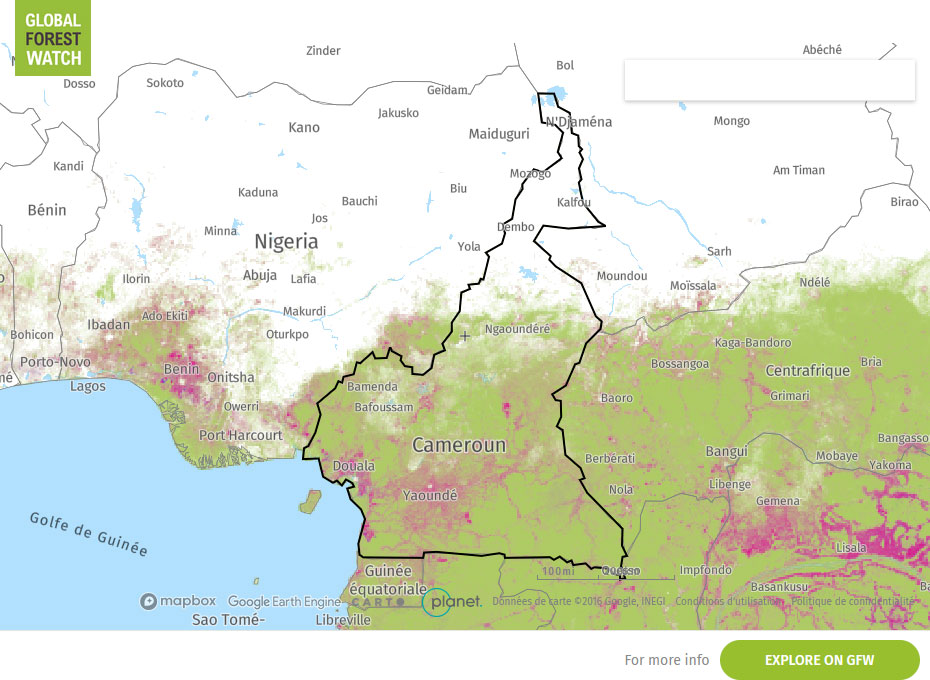Forest resources and context of Cameroon
According to the Ministry of Forests and Wildlife (2018), Cameroon has about 22 million hectares of forests, or nearly 46% of the total country area. 26 000 hectares (0.1% of the forest area) is categorised as planted forest.

Land surface
47.3million ha
Forest cover
20.2million ha
Production forest
15.7million ha
Forest ownership
100% publicly
Forest resources in Cameroon
Types of forest
Cameroon’s forests are mainly tropical rainforests of two predominant types: lowland evergreen (54% of total forest area), and lowland semi-deciduous (28%). The evergreen forests can be divided into two broad categories: The Biafran forests, a low altitude coastal forest along the Gulf of Guinea, and the Congo Basin forests in Cameroon’s south and southeast. Biafran forests have been largely cleared, but where it still exists, it is characterised by species such as Azobé (Lophira alata) and Ozouga (Sacoglottis gabonensis).
The composition of species in the Guinean-Congolese forests differs significantly from that of the Biafran forest due to the absence of gregarious Caesalpiniacae, with the notable exception of the Limbali (Gilbertiodendron dewevrei). Another characteristic is the significant number of Moabi (Baillonella toxisperma). Other commercial tree species harvested include Sapelli (Entandrophragma cylindricum) and Sipo (Entandrophragma utile) and Ayous (Triplochiton scleroxylon). The dense semi-deciduous medium-altitude forest is characterised by its abundance of Sterculiaceae. They are particularly rich in species that lend themselves to peeling (FAO).
According to the Ministry of Forests and Wildlife (MINFOF, 2018), Cameroon has about 22 million hectares of forests, or nearly 46% of the total country area. 26 000 hectares (0.1% of the forest area) is categorised as planted forest. Another FAO study in 2020, counts 20.2 million hectares of forest. According to the 2018 FRMI study, 8.5 million hectares are dedicated to forestry production.
The main drivers of deforestation in Cameroon are (i) conversion to agriculture, from both large and medium-scale plantations, as well as smallholders, (ii) fuel-wood harvesting, (iii) mining and (iv) infrastructure development. Unsustainable and illegal logging is also to blame for the degradation of Cameroon's forests. Illegal logging has long been recognised as a significant problem in Cameroon. Concerns have been raised over the misuse of certain logging permits in the country, and the lack of effective regulation and law enforcement.
Forest ownership in Cameroon
The Forest Law (1994) divides the forest area into non-permanent forest estate (domaine forestier non-permanent), including community forest and private forest, and permanent forest estate (domaine forestier permanent). The permanent forest estate includes forest reserves, logging concessions, protected areas and council forests. Protected areas, including national parks, forest reserves and hunting zones, currently cover 20 per cent of the national forest area. (WRI, 2017). The permanent forest estate are owned by the state, although for a large part of this forest area the management rights are transferred to other parties. Generally, people living in forest areas fully retain their traditional user rights.
In the non-permanent forest estate, non-allocated lands are mainly used by local communities for farms and other purposes, and allocation of these lands to communities shall follow formal procedures. However, disputes over forest ownership and the demarcation of boundaries have been common in the past and remain so today.
key figures
| Land surface | 47.3 million hectares |
|---|---|
| Forest cover | 18.8 million hectares (39.8%) |
| Production forest | 15.7 million hectares designated for production |
| Forest ownership | 100% publicly owned |
| Annual change rate | -1% per year; over the past 25 years (1990-2015) |
Source: FAO, 2015
See also: Global Forest Ressources Assessment 2020, FAO



